RSCH 8110: Qualitative Research Discussion on Quality Criteria
VerifiedAdded on 2022/12/05
|6
|1352
|279
Discussion Board Post
AI Summary
This discussion post delves into the evaluation of qualitative research designs, contrasting them with quantitative methods. It highlights the importance of impact and importance, emphasizing the need to address research gaps and provide practical solutions. The post stresses the significance of transparency, requiring clear documentation of the research journey, including study design, sampling, and data analysis, to ensure trustworthiness. It explores the interpretivist paradigm, its assumptions about reality, and the role of researchers as co-creators of knowledge. Ethical considerations, particularly confidentiality, are addressed, emphasizing the need for informed consent and anonymity. The discussion concludes by defining amenability to scientific study in qualitative research, which hinges on the alignment of the research design with the research problem and the researcher's competence in making appropriate methodological decisions. The discussion emphasizes the need to balance flexibility and personalization with transparency and ethical rigor.
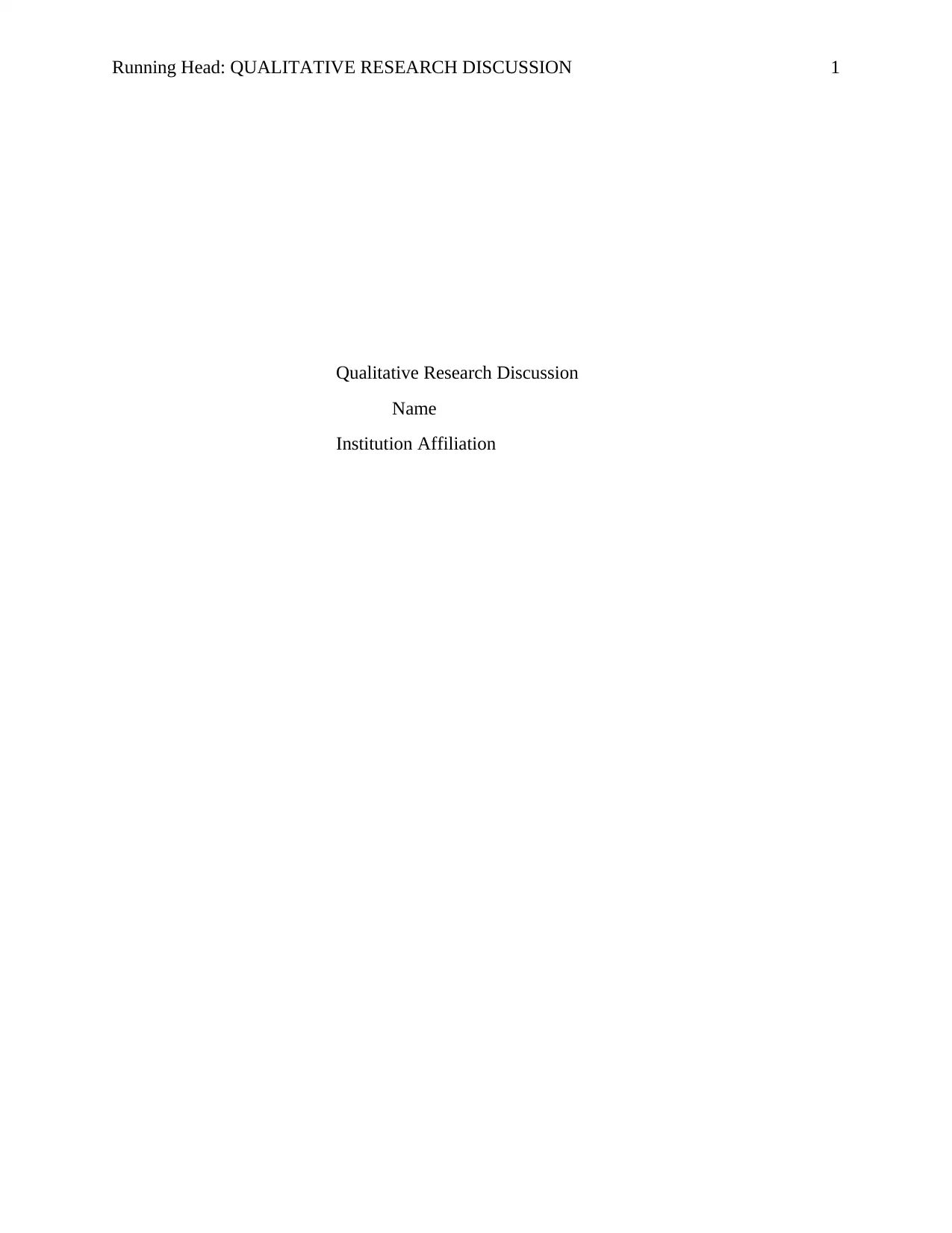
Running Head: QUALITATIVE RESEARCH DISCUSSION 1
Qualitative Research Discussion
Name
Institution Affiliation
Qualitative Research Discussion
Name
Institution Affiliation
Paraphrase This Document
Need a fresh take? Get an instant paraphrase of this document with our AI Paraphraser
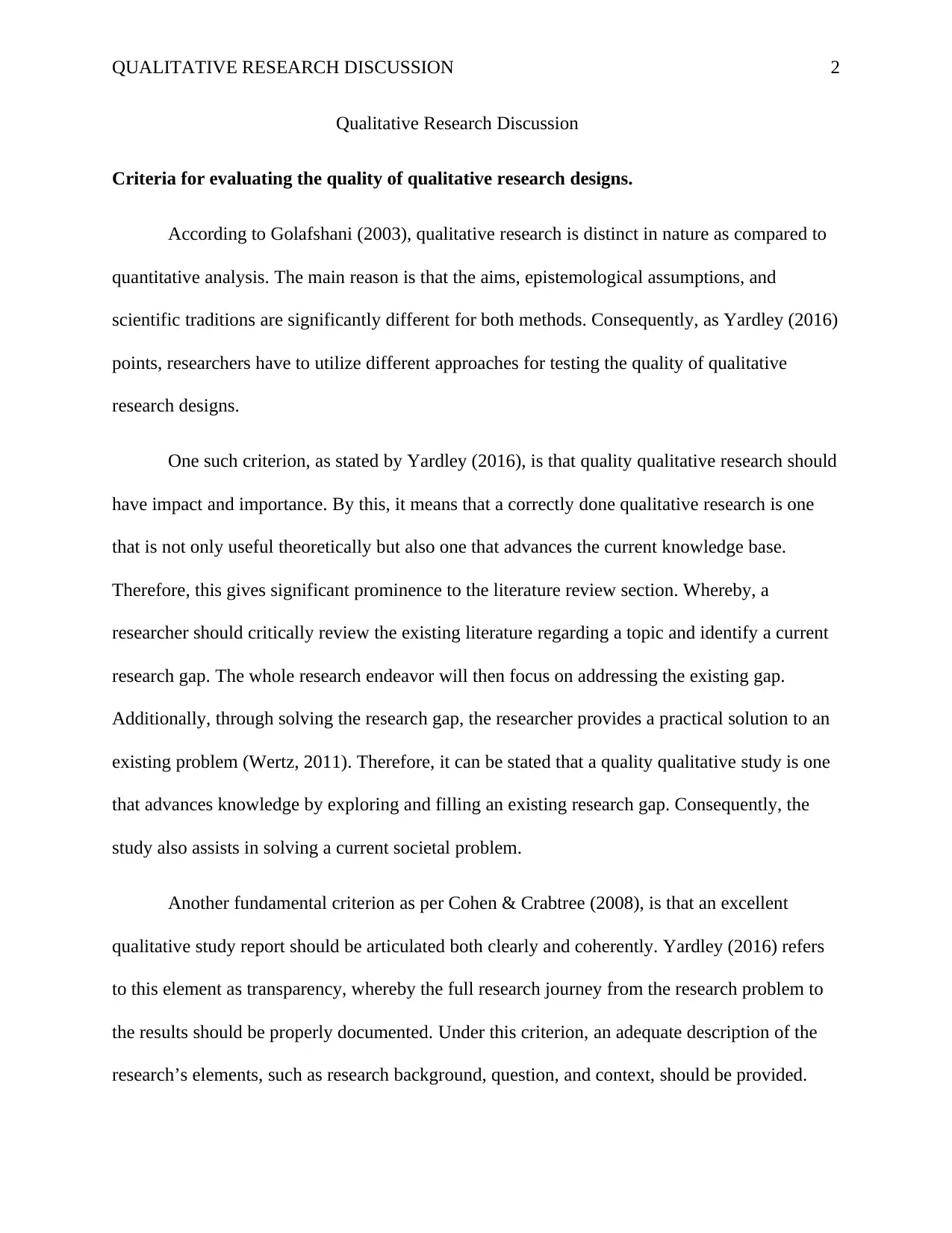
QUALITATIVE RESEARCH DISCUSSION 2
Qualitative Research Discussion
Criteria for evaluating the quality of qualitative research designs.
According to Golafshani (2003), qualitative research is distinct in nature as compared to
quantitative analysis. The main reason is that the aims, epistemological assumptions, and
scientific traditions are significantly different for both methods. Consequently, as Yardley (2016)
points, researchers have to utilize different approaches for testing the quality of qualitative
research designs.
One such criterion, as stated by Yardley (2016), is that quality qualitative research should
have impact and importance. By this, it means that a correctly done qualitative research is one
that is not only useful theoretically but also one that advances the current knowledge base.
Therefore, this gives significant prominence to the literature review section. Whereby, a
researcher should critically review the existing literature regarding a topic and identify a current
research gap. The whole research endeavor will then focus on addressing the existing gap.
Additionally, through solving the research gap, the researcher provides a practical solution to an
existing problem (Wertz, 2011). Therefore, it can be stated that a quality qualitative study is one
that advances knowledge by exploring and filling an existing research gap. Consequently, the
study also assists in solving a current societal problem.
Another fundamental criterion as per Cohen & Crabtree (2008), is that an excellent
qualitative study report should be articulated both clearly and coherently. Yardley (2016) refers
to this element as transparency, whereby the full research journey from the research problem to
the results should be properly documented. Under this criterion, an adequate description of the
research’s elements, such as research background, question, and context, should be provided.
Qualitative Research Discussion
Criteria for evaluating the quality of qualitative research designs.
According to Golafshani (2003), qualitative research is distinct in nature as compared to
quantitative analysis. The main reason is that the aims, epistemological assumptions, and
scientific traditions are significantly different for both methods. Consequently, as Yardley (2016)
points, researchers have to utilize different approaches for testing the quality of qualitative
research designs.
One such criterion, as stated by Yardley (2016), is that quality qualitative research should
have impact and importance. By this, it means that a correctly done qualitative research is one
that is not only useful theoretically but also one that advances the current knowledge base.
Therefore, this gives significant prominence to the literature review section. Whereby, a
researcher should critically review the existing literature regarding a topic and identify a current
research gap. The whole research endeavor will then focus on addressing the existing gap.
Additionally, through solving the research gap, the researcher provides a practical solution to an
existing problem (Wertz, 2011). Therefore, it can be stated that a quality qualitative study is one
that advances knowledge by exploring and filling an existing research gap. Consequently, the
study also assists in solving a current societal problem.
Another fundamental criterion as per Cohen & Crabtree (2008), is that an excellent
qualitative study report should be articulated both clearly and coherently. Yardley (2016) refers
to this element as transparency, whereby the full research journey from the research problem to
the results should be properly documented. Under this criterion, an adequate description of the
research’s elements, such as research background, question, and context, should be provided.
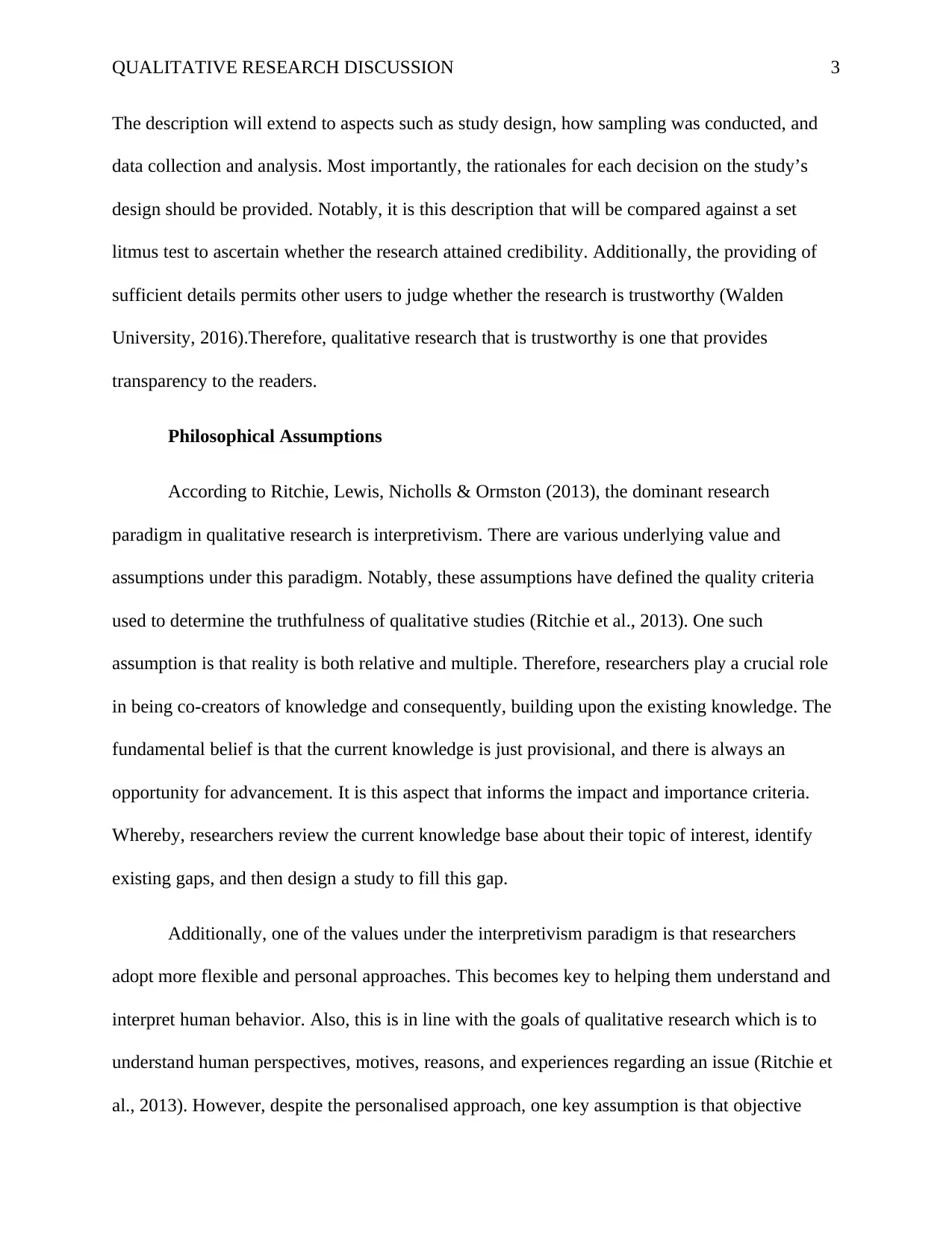
QUALITATIVE RESEARCH DISCUSSION 3
The description will extend to aspects such as study design, how sampling was conducted, and
data collection and analysis. Most importantly, the rationales for each decision on the study’s
design should be provided. Notably, it is this description that will be compared against a set
litmus test to ascertain whether the research attained credibility. Additionally, the providing of
sufficient details permits other users to judge whether the research is trustworthy (Walden
University, 2016).Therefore, qualitative research that is trustworthy is one that provides
transparency to the readers.
Philosophical Assumptions
According to Ritchie, Lewis, Nicholls & Ormston (2013), the dominant research
paradigm in qualitative research is interpretivism. There are various underlying value and
assumptions under this paradigm. Notably, these assumptions have defined the quality criteria
used to determine the truthfulness of qualitative studies (Ritchie et al., 2013). One such
assumption is that reality is both relative and multiple. Therefore, researchers play a crucial role
in being co-creators of knowledge and consequently, building upon the existing knowledge. The
fundamental belief is that the current knowledge is just provisional, and there is always an
opportunity for advancement. It is this aspect that informs the impact and importance criteria.
Whereby, researchers review the current knowledge base about their topic of interest, identify
existing gaps, and then design a study to fill this gap.
Additionally, one of the values under the interpretivism paradigm is that researchers
adopt more flexible and personal approaches. This becomes key to helping them understand and
interpret human behavior. Also, this is in line with the goals of qualitative research which is to
understand human perspectives, motives, reasons, and experiences regarding an issue (Ritchie et
al., 2013). However, despite the personalised approach, one key assumption is that objective
The description will extend to aspects such as study design, how sampling was conducted, and
data collection and analysis. Most importantly, the rationales for each decision on the study’s
design should be provided. Notably, it is this description that will be compared against a set
litmus test to ascertain whether the research attained credibility. Additionally, the providing of
sufficient details permits other users to judge whether the research is trustworthy (Walden
University, 2016).Therefore, qualitative research that is trustworthy is one that provides
transparency to the readers.
Philosophical Assumptions
According to Ritchie, Lewis, Nicholls & Ormston (2013), the dominant research
paradigm in qualitative research is interpretivism. There are various underlying value and
assumptions under this paradigm. Notably, these assumptions have defined the quality criteria
used to determine the truthfulness of qualitative studies (Ritchie et al., 2013). One such
assumption is that reality is both relative and multiple. Therefore, researchers play a crucial role
in being co-creators of knowledge and consequently, building upon the existing knowledge. The
fundamental belief is that the current knowledge is just provisional, and there is always an
opportunity for advancement. It is this aspect that informs the impact and importance criteria.
Whereby, researchers review the current knowledge base about their topic of interest, identify
existing gaps, and then design a study to fill this gap.
Additionally, one of the values under the interpretivism paradigm is that researchers
adopt more flexible and personal approaches. This becomes key to helping them understand and
interpret human behavior. Also, this is in line with the goals of qualitative research which is to
understand human perspectives, motives, reasons, and experiences regarding an issue (Ritchie et
al., 2013). However, despite the personalised approach, one key assumption is that objective
⊘ This is a preview!⊘
Do you want full access?
Subscribe today to unlock all pages.

Trusted by 1+ million students worldwide
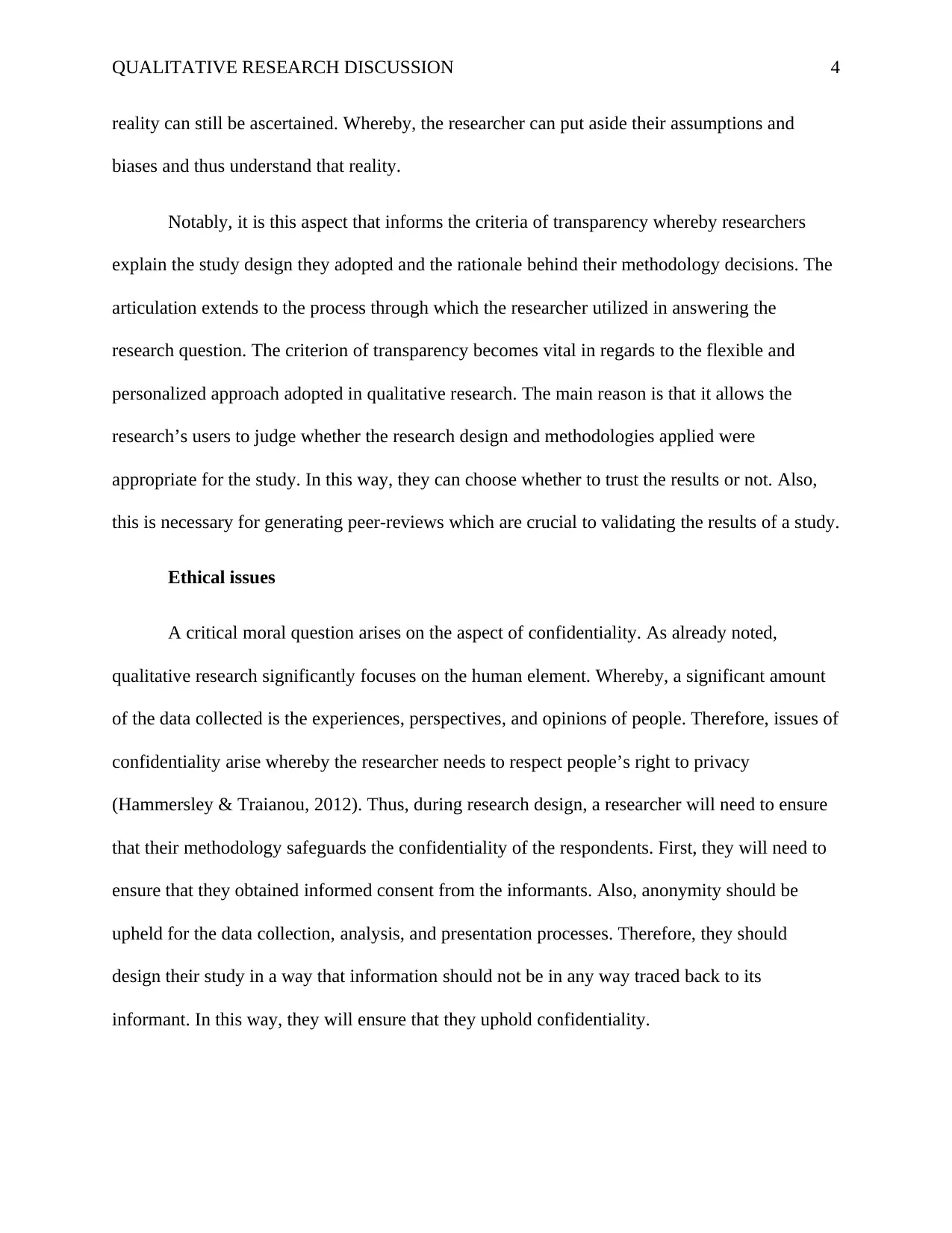
QUALITATIVE RESEARCH DISCUSSION 4
reality can still be ascertained. Whereby, the researcher can put aside their assumptions and
biases and thus understand that reality.
Notably, it is this aspect that informs the criteria of transparency whereby researchers
explain the study design they adopted and the rationale behind their methodology decisions. The
articulation extends to the process through which the researcher utilized in answering the
research question. The criterion of transparency becomes vital in regards to the flexible and
personalized approach adopted in qualitative research. The main reason is that it allows the
research’s users to judge whether the research design and methodologies applied were
appropriate for the study. In this way, they can choose whether to trust the results or not. Also,
this is necessary for generating peer-reviews which are crucial to validating the results of a study.
Ethical issues
A critical moral question arises on the aspect of confidentiality. As already noted,
qualitative research significantly focuses on the human element. Whereby, a significant amount
of the data collected is the experiences, perspectives, and opinions of people. Therefore, issues of
confidentiality arise whereby the researcher needs to respect people’s right to privacy
(Hammersley & Traianou, 2012). Thus, during research design, a researcher will need to ensure
that their methodology safeguards the confidentiality of the respondents. First, they will need to
ensure that they obtained informed consent from the informants. Also, anonymity should be
upheld for the data collection, analysis, and presentation processes. Therefore, they should
design their study in a way that information should not be in any way traced back to its
informant. In this way, they will ensure that they uphold confidentiality.
reality can still be ascertained. Whereby, the researcher can put aside their assumptions and
biases and thus understand that reality.
Notably, it is this aspect that informs the criteria of transparency whereby researchers
explain the study design they adopted and the rationale behind their methodology decisions. The
articulation extends to the process through which the researcher utilized in answering the
research question. The criterion of transparency becomes vital in regards to the flexible and
personalized approach adopted in qualitative research. The main reason is that it allows the
research’s users to judge whether the research design and methodologies applied were
appropriate for the study. In this way, they can choose whether to trust the results or not. Also,
this is necessary for generating peer-reviews which are crucial to validating the results of a study.
Ethical issues
A critical moral question arises on the aspect of confidentiality. As already noted,
qualitative research significantly focuses on the human element. Whereby, a significant amount
of the data collected is the experiences, perspectives, and opinions of people. Therefore, issues of
confidentiality arise whereby the researcher needs to respect people’s right to privacy
(Hammersley & Traianou, 2012). Thus, during research design, a researcher will need to ensure
that their methodology safeguards the confidentiality of the respondents. First, they will need to
ensure that they obtained informed consent from the informants. Also, anonymity should be
upheld for the data collection, analysis, and presentation processes. Therefore, they should
design their study in a way that information should not be in any way traced back to its
informant. In this way, they will ensure that they uphold confidentiality.
Paraphrase This Document
Need a fresh take? Get an instant paraphrase of this document with our AI Paraphraser
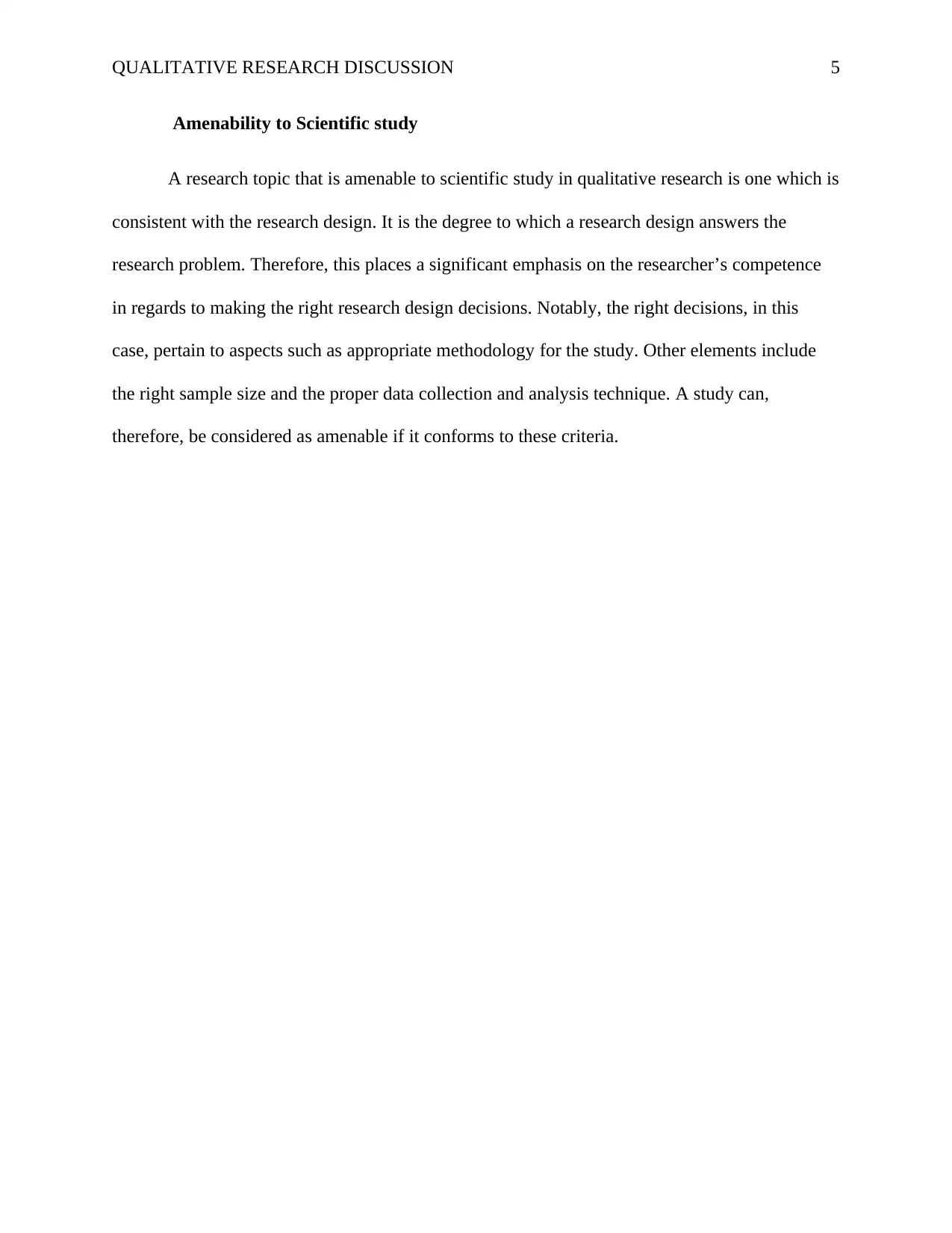
QUALITATIVE RESEARCH DISCUSSION 5
Amenability to Scientific study
A research topic that is amenable to scientific study in qualitative research is one which is
consistent with the research design. It is the degree to which a research design answers the
research problem. Therefore, this places a significant emphasis on the researcher’s competence
in regards to making the right research design decisions. Notably, the right decisions, in this
case, pertain to aspects such as appropriate methodology for the study. Other elements include
the right sample size and the proper data collection and analysis technique. A study can,
therefore, be considered as amenable if it conforms to these criteria.
Amenability to Scientific study
A research topic that is amenable to scientific study in qualitative research is one which is
consistent with the research design. It is the degree to which a research design answers the
research problem. Therefore, this places a significant emphasis on the researcher’s competence
in regards to making the right research design decisions. Notably, the right decisions, in this
case, pertain to aspects such as appropriate methodology for the study. Other elements include
the right sample size and the proper data collection and analysis technique. A study can,
therefore, be considered as amenable if it conforms to these criteria.
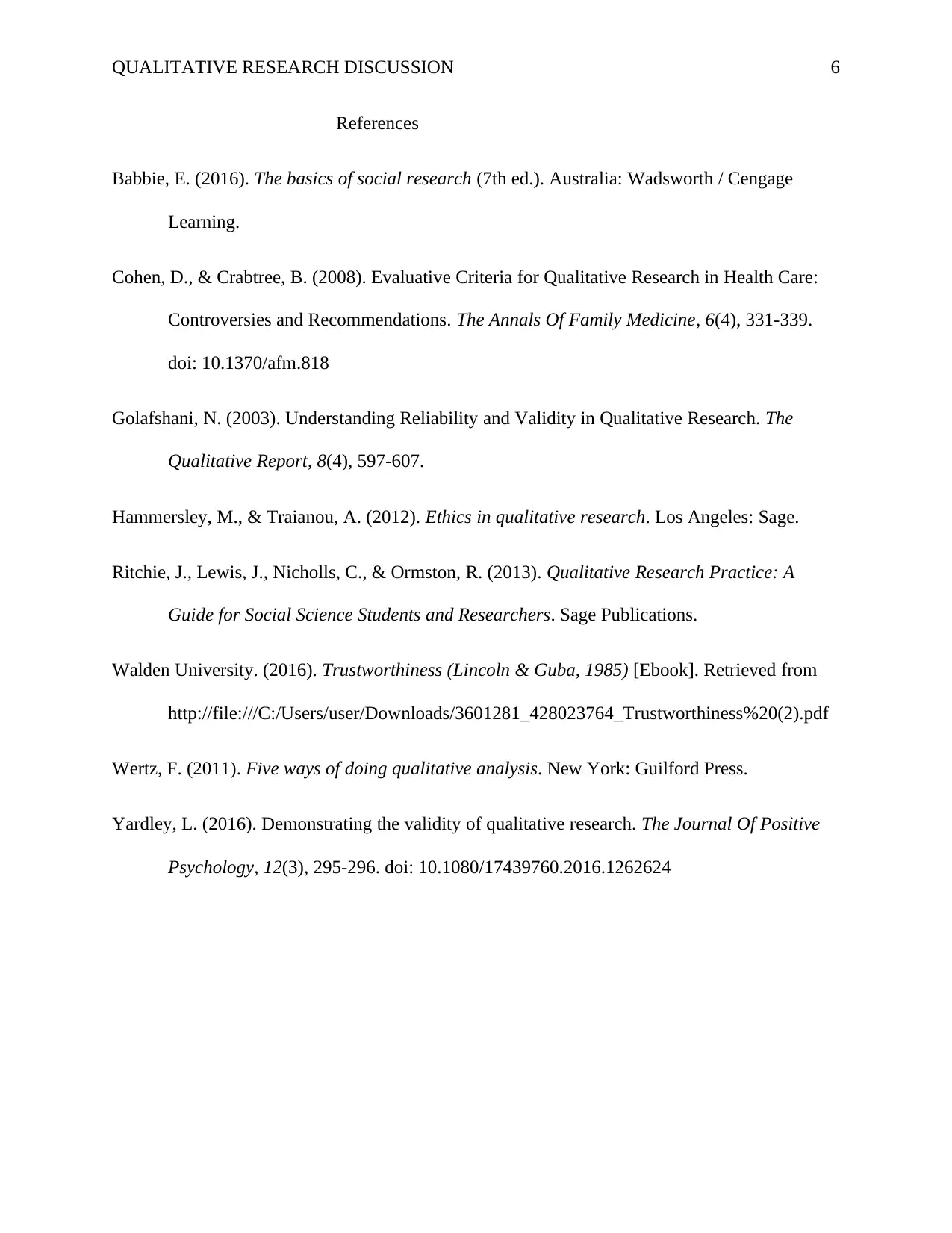
QUALITATIVE RESEARCH DISCUSSION 6
References
Babbie, E. (2016). The basics of social research (7th ed.). Australia: Wadsworth / Cengage
Learning.
Cohen, D., & Crabtree, B. (2008). Evaluative Criteria for Qualitative Research in Health Care:
Controversies and Recommendations. The Annals Of Family Medicine, 6(4), 331-339.
doi: 10.1370/afm.818
Golafshani, N. (2003). Understanding Reliability and Validity in Qualitative Research. The
Qualitative Report, 8(4), 597-607.
Hammersley, M., & Traianou, A. (2012). Ethics in qualitative research. Los Angeles: Sage.
Ritchie, J., Lewis, J., Nicholls, C., & Ormston, R. (2013). Qualitative Research Practice: A
Guide for Social Science Students and Researchers. Sage Publications.
Walden University. (2016). Trustworthiness (Lincoln & Guba, 1985) [Ebook]. Retrieved from
http://file:///C:/Users/user/Downloads/3601281_428023764_Trustworthiness%20(2).pdf
Wertz, F. (2011). Five ways of doing qualitative analysis. New York: Guilford Press.
Yardley, L. (2016). Demonstrating the validity of qualitative research. The Journal Of Positive
Psychology, 12(3), 295-296. doi: 10.1080/17439760.2016.1262624
References
Babbie, E. (2016). The basics of social research (7th ed.). Australia: Wadsworth / Cengage
Learning.
Cohen, D., & Crabtree, B. (2008). Evaluative Criteria for Qualitative Research in Health Care:
Controversies and Recommendations. The Annals Of Family Medicine, 6(4), 331-339.
doi: 10.1370/afm.818
Golafshani, N. (2003). Understanding Reliability and Validity in Qualitative Research. The
Qualitative Report, 8(4), 597-607.
Hammersley, M., & Traianou, A. (2012). Ethics in qualitative research. Los Angeles: Sage.
Ritchie, J., Lewis, J., Nicholls, C., & Ormston, R. (2013). Qualitative Research Practice: A
Guide for Social Science Students and Researchers. Sage Publications.
Walden University. (2016). Trustworthiness (Lincoln & Guba, 1985) [Ebook]. Retrieved from
http://file:///C:/Users/user/Downloads/3601281_428023764_Trustworthiness%20(2).pdf
Wertz, F. (2011). Five ways of doing qualitative analysis. New York: Guilford Press.
Yardley, L. (2016). Demonstrating the validity of qualitative research. The Journal Of Positive
Psychology, 12(3), 295-296. doi: 10.1080/17439760.2016.1262624
⊘ This is a preview!⊘
Do you want full access?
Subscribe today to unlock all pages.

Trusted by 1+ million students worldwide
1 out of 6
Related Documents
Your All-in-One AI-Powered Toolkit for Academic Success.
+13062052269
info@desklib.com
Available 24*7 on WhatsApp / Email
![[object Object]](/_next/static/media/star-bottom.7253800d.svg)
Unlock your academic potential
Copyright © 2020–2025 A2Z Services. All Rights Reserved. Developed and managed by ZUCOL.





